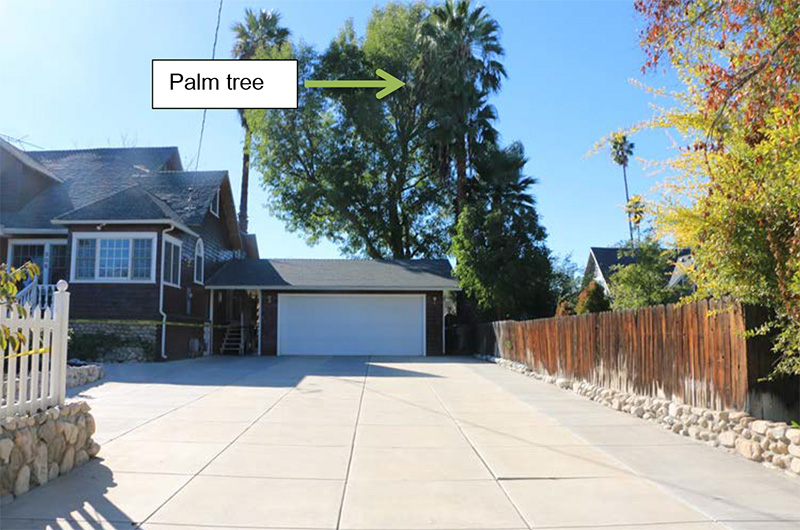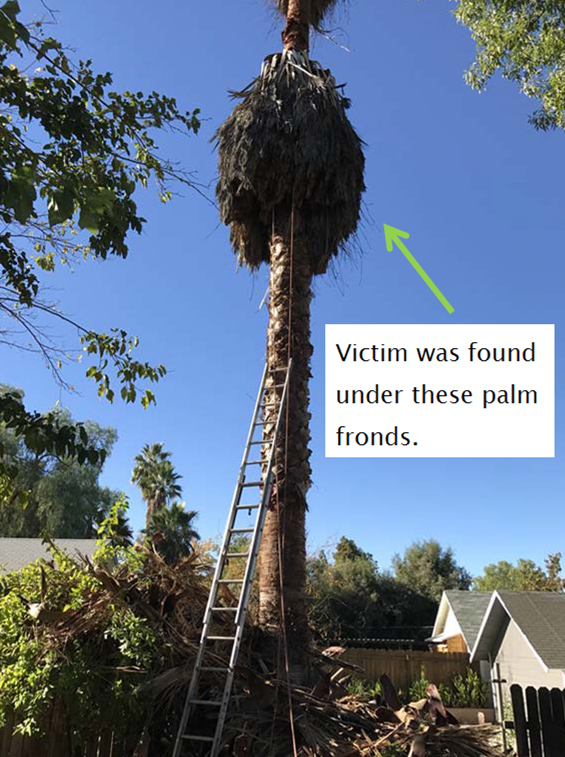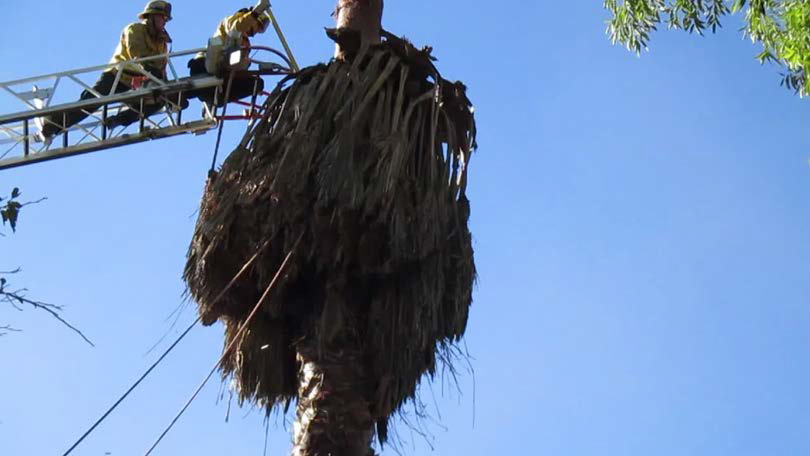Case Report: 16CA007
Landscaper dies from asphyxia when compressed by palm fronds
Download a PDF to print this report:
Landscaper dies from asphyxia when compressed by palm fronds (16CA007, PDF)
Summary
A landscaper died while trimming a palm tree in the back yard of a homeowner. Neither the victim nor the landscaper who hired him were certified tree trimmers. The palm tree was approximately 60 feet high. The victim was about halfway up the tree when the skirt of dead palm fronds directly above him broke loose and slid down, compressing him against the tree trunk and suffocating him. The fire department performed a technical rescue, but when they reached the victim he was in cardiac arrest. The CA/FACE investigator determined that, in order to prevent future incidents, landscapers and self-employed tree trimmers who trim or remove palm trees should ensure that:
- Palm tree trimming or removal is performed or supervised by workers trained and certified by organizations such as the Tree Care Industry Association (TCIA) or the International Society of Arboriculture (ISA).
- Proper work procedures and equipment are used, such as using an aerial lift and cutting fronds from above.
In addition, property owners who need palm trees trimmed or removed should:
- Only hire tree trimmers who are certified by organizations such as TCIA or ISA. In addition, they should only hire companies that have a current tree trimming contractor's license (in states where this is applicable).
Also, fire departments in locations with palm trees should:
- Develop and implement rescue protocols for trapped palm tree trimmers.
Introduction
On December 4, 2016, a 35-year-old male Hispanic landscaper (victim) died while trimming a 60-foot palm tree in the backyard of a private residence. The CA/FACE investigator received notification of this incident on December 6, 2016, by the Cal/OSHA Weekly Update. On January 12, 2017, the CA/FACE investigator made contact with the landscaper hired by the homeowner(landscaper #1). Landscaper #1 was interviewed on January 23, 2017, and the homeowner was interviewed on March 21, 2017. The incident scene was inspected on January 9, 2017. The county coroner and police reports were obtained and reviewed. Contact with a second landscaper (landscaper #2) who was present on the day of the incident was unsuccessful.
Employer
The employer in this incident (landscaper #1) was an individual who had been performing landscape work for a neighbor. He stated he was not operating a licensed business and was not a licensed landscape contractor. He asked two other landscapers (victim and landscaper #2) to assist him with trimming the palm tree. He had been performing landscape work for 25 years but had never received specific training on how to trim palm trees. The employer was fluent in Spanish and knew some English.
Written Safety Programs and Training
There was no written Injury and Illness Prevention Program (IIPP). Landscaper #1 had never attended a formal class or received certification on tree trimming. It is not known whether the victim or landscaper #2 had received formal training, but neither was certified.
Worker Information
The victim was a Hispanic male who was hired (sub-contracted) by landscaper #1 to trim the palm tree. Landscaper #1 stated that he had known the victim for eleven years and worked with him on many other jobs. It is not known how much experience landscaper #1 or the victim had trimming palm trees.
Incident Scene
The incident scene was the backyard of a home in a residential neighborhood. The fenced backyard contained an approximately 60-foot palm tree with many years of dead palm fronds. The backyard was surrounded on all sides by neighboring properties. The only access to the backyard was through a passageway between the attached garage and the fence. The neighbor had an asphalt driveway adjacent to the back fence that provided access for rescue crew equipment.
Investigation
The homeowner stated that he hired landscaper #1 to trim the palm tree, as he had been performing landscape work for a neighbor. The homeowner did not know whether landscaper #1 was a certified tree trimmer. On the day of the incident, landscaper #1 arrived with the victim and landscaper #2 at about 8:30 a.m. The victim was equipped with a climbing harness and strap, tree climbing spikes, gloves, safety glasses, hard hat, and a chain saw. He climbed a straight ladder to gain access to the tree, then secured himself with the strap to the trunk of the tree, climbed up and under the dead palm fronds, and began cutting and pulling them off. Some palm fronds fell to the ground, and others clung to each other, creating a loose skirt around the tree trunk. The two workers on the ground gathered up the palm fronds that fell and hauled them to the truck for disposal.
At approximately 9:30 a.m., the victim climbed down from under the palm frond skirt to the ladder used to gain access to the tree. He then lowered the chain saw with a rope to landscaper #1 to be refueled. He refueled it and then sent it back up to the victim. The victim started climbing back up the tree. When he got just below the dead palm fronds, the skirt of cut fronds suddenly shifted and collapsed around and onto him, pressing him against the trunk of the tree.
The two workers on the ground tried to rescue the victim as he yelled for help, but he was too high up on the tree for them to reach. 911 was called at 9:56 a.m. The local fire department responded within six minutes to the scene and tried to reach the victim with extension ladders. A neighboring city also received the call and responded with a 75-foot ladder truck to perform the rescue. The ladder truck was moved to the neighbor’s driveway to gain access to the tree. Once the truck was in place, the ladder was extended at a fairly low angle and the dead palm fronds were cut away.
Firefighters were able to extricate the victim, but he was unresponsive and had no pulse. The victim was placed onto a backboard, brought down the ladder truck, and placed onto the gurney where CPR and other medical treatments were performed. He was transported by ambulance to the local hospital where they continued treatment for another 20 minutes before he was pronounced dead by the attending doctor. All responding units cleared the incident scene between 11:03 and 11:25 am. The time that elapsed performing the rescue was approximately 61 minutes.
Contributing Factors
Occupational injuries and fatalities are often the result of one or more contributing factors or key events in a larger sequence of events that ultimately result in an injury or fatality. The CA/FACE investigator identified numerous improper work practices (such as removing multiple years of frond growth from below) and the shortage of correct equipment as contributing factors in this incident that ultimately led to the fatality.
Cause of Death
The cause of death according to the death certificate was restrictive asphyxia.
Recommendations
The CA/FACE investigator determined that, in order to prevent future incidents, landscapers and self-employed tree trimmers who trim or remove palm trees should ensure that:
Recommendation #1: Palm tree trimming or removal is performed or supervised by workers trained and certified by organizations such as the Tree Care Industry Association (TCIA) or the International Society of Arboriculture (ISA).
Discussion: In this incident, the victim had many years of experience in tree trimming and may have been familiar with general safety procedures. However, it is not clear if this experience included knowledge of the best methods for trimming palm trees, or if the victim’s skills had been assessed through job supervision and testing. The TCIA and ISA are two organizations that certify tree trimmers in all aspects of job safety, including the best methods for trimming palm trees. All TCIA-and ISA-certified tree workers must attend formal trainings and pass a knowledge and skills exam conducted by trained evaluators. If the victim had received certification or was supervised by someone who was certified, he or the supervisor may have had the knowledge to recognize the unique hazards posed by palm fronds and performed the job in a safe manner, possibly preventing this fatality.
Recommendation #2: Proper work procedures and equipment are used, such as using an aerial lift and cutting fronds from above.
Discussion: Safe methods for trimming palm trees include using a bucket truck or aerial device equipped with fall protection. When the use of a bucket truck/aerial device is not practical because of the tree location, workers may use a newly developed climbing procedure created by arborists in the San Diego and Los Angeles area that suspends the tree worker from the top of a palm tree, eliminating the need for working under the skirt. This procedure, which should only be used by a trained and experienced tree worker, involves:
- Using ropes, tools, and equipment designed for arborist work, and assuring this equipment is serviceable.
- Installing a throw line through the top of the palm tree needing trimming.
- Attaching an approved anchor line and pulley (block) to the throw line.
- Threading an approved climbing line through the block and hauling the block into the canopy, above the skirt of dead fronds. The climbing line must be long enough that when the block is raised, both ends of the climbing line will reach the ground.
- Securing the anchor line away from the base of the tree.
- Tying a friction hitch to the climbing line before ascending the tree, so that the worker is secured against falling at all times while aloft.
- Having one or two ground workers available, properly trained and equipped to assist the climber if needed.
The CA/FACE video,
Preventing Palm Tree Trimmer Fatalities, available in English and Spanish, demonstrates this procedure. Had the victim used these safe methods, this fatality may have been prevented.
Recommendation #3: Property owners should only hire tree trimmers who are certified by organizations such as TCIA or ISA. In addition, they should only hire companies that have a current tree trimming contractor's license (in states where this is applicable).
Discussion: In this incident, the homeowner hired a landscaper who was not a certified tree trimmer. A certified tree trimmer is an individual who has met specific qualifications and has demonstrated an acceptable level of skill and proficiency. When hiring a certified tree trimmer, homeowners are more likely to be dealing with a company with a standard of professionalism that protects consumers by:
- Having policies that promote the health, safety, and general welfare of the public.
- Ensuring that tree trimming is performed in a safe, competent, and professional manner.
- Adhering to the laws, regulations, and standards governing tree trimming.
- Providing resolution to disputes that arise from tree trimming activities.
- Educating consumers so that they make informed choices.
Had the homeowner hired a tree trimmer who was certified, this incident might have been prevented. In addition, homeowners should hire tree trimming companies that have a current contractor’s license. Under certain circumstances, homeowners may be liable for worker injuries or deaths that occur on their property if they hire unlicensed tree trimmers.
Recommendation #4: Fire departments in locations with palm trees should develop and implement rescue protocols for trapped palm tree trimmers.
Discussion: In this incident, several minutes passed between the arrival of the ladder truck, locating the victim within the drooping palm fronds, deciding the best ladder approach to the victim, and maneuvering the ladder truck into place given the difficult placement of the tree so far from the street and in a backyard. In this incident, many of the personnel on the rescue team had manipulative (demonstration, simulation) training and had reviewed training and lessons learned on these types of incidents from other agencies prior to the incident. A regular duty firefighter would not routinely be trained on the risk of palm frond suffocation or the most expeditious approach to reach and rescue the trapped victim. Fire departments that have a need to perform palm tree rescues should develop and implement a standard rescue protocol. This protocol should address:
- Written scripts for the initial dispatch.
- The proper mix of equipment and personnel, including at least two ladder trucks.
- The necessity of having pumpers on standby to wet the tree in case a tree worker's chainsaw or an electrical line has set the fronds on fire.
- Training every firefighter in the usual cause of death by suffocation from palm frond weight and the urgency of quick response.
- Training every firefighter in the choices for approaching the rescue (platform/ladder/lines)and how to set up the equipment for the rescue.
- Training all firefighters in the initial actions to be taken when the victim is first reached.
- The specialized technical training that the Urban Search and Rescue Task Force will require to perform the actual rescue.
Additional scrutiny needs to be given to the issue of aerial platform equipment availability. The firefighters in this case were able to reach, treat, and rescue the victim using a ladder truck. In most palm rescues, and in many other types of technical rescues, the added stability of an aerial platform rather than just ladder trucks can provide additional measures of speed and safety. Public emergency response agencies should consider the benefits of aerial platform trucks in large metropolitan areas. It is possible that implementation of a more extensive palm tree rescue program with additional training of the first responders to the scene may have decreased the time needed to reach the victim and prevented this fatality.
References
Division of Occupational Safety and Health -Title 8 regulations -Subchapter 7 -General Industry Safety Orders Group 3. Tree Work, Maintenance or Removal §3421. General. §3427. Safe Work Procedures. §3428. Operating Rules.
NIOSH Issues Nationwide Alert on Dangers of Tree Trimming - NIOSH update
Team-Based Palm Tree Rescue - FireRescue Magazine article
Pruning Palm Trees Safely (PDF) - Tree Care Industry Magazine
Exhibits

Exhibit #1. The residence with the palm tree involved in the incident in the backyard.

Exhibit #2. The palm fronds that formed a skirt that engulfed the victim.

Exhibit #3. Fire department responding to this incident. Photo courtesy Redlands Fire Department.
Authors
Hank Cierpich, FACE Investigator
Robert Harrison, MD, MPH, FACE Project Officer
Laura Styles, MPH, Research Scientist
October 30, 2017